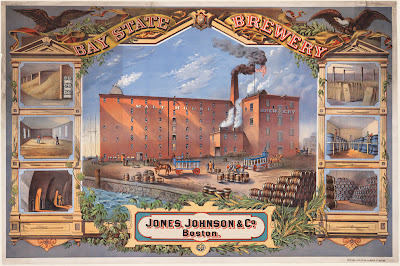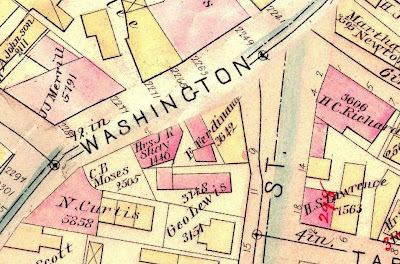 Boston City Hospital, from Harrison avenue.
Boston City Hospital, from Harrison avenue.
The official history of Boston City Hospital begins in 1861, when money was put aside to build a facility for the 'worthy poor.' The site chosen was filled land already owned by the city in the new South End. Unfortunately, it also sat adjacent to Roxbury Canal, which carried sewage from that town to Boston harbor. The main campus of the hospital consisted of 10 acres of land. This property had previously been known as the Agricultural Fairgrounds (!), and regularly flooded over at high tide.
Over the years, many buildings were added to the facility, including more patient's wards, a power plant, nurse's housing, medical laboratories, a mortuary and an ambulance headquarters.
 Panoramic view of Boston City Hospital from Harrison avenue, 1901 (snapshotsofthepast.com Flickr page).
Panoramic view of Boston City Hospital from Harrison avenue, 1901 (snapshotsofthepast.com Flickr page).
 Boston City Hospital, 1929. Dome of central administration in seen in the center of the complex (BPL).
Boston City Hospital, 1929. Dome of central administration in seen in the center of the complex (BPL).
 Boston City Hospital 1883 . The two top images are oriented from Harrison avenue, at the upper left of this map, looking towards the lower right.
Boston City Hospital 1883 . The two top images are oriented from Harrison avenue, at the upper left of this map, looking towards the lower right.
 Boston City Hospital 1888. Buildings have been added at the lower corner of the property.
Boston City Hospital 1888. Buildings have been added at the lower corner of the property.
 Boston City Hospital 1895. More buildings added, and East Springfield street and the land between the hospital and Massachusetts avenue has been taken by the city and added to the campus. There is also now a south campus on the opposite side of Massachusetts avenue. Note the Roxbury Canal, yet to be filled in, at the lower right corner.
Boston City Hospital 1895. More buildings added, and East Springfield street and the land between the hospital and Massachusetts avenue has been taken by the city and added to the campus. There is also now a south campus on the opposite side of Massachusetts avenue. Note the Roxbury Canal, yet to be filled in, at the lower right corner.
 Boston City Hospital 1938.
Boston City Hospital 1938.
 Convalescent Home, 1890.
Convalescent Home, 1890.
 Convalescent home, Lower Mills.
Convalescent home, Lower Mills.
City Hospital had auxiliary facilities at opposite ends of the city. The city purchased a country estate of 14 acres on Dorchester avenue near Lower Mills in 1890 to serve as a convalescent home for women and children - apparently, men were on their own. Patients were being sent home too early, and returning soon after. They raised vegetables on the property to serve patients, and flowers from the gardens were sent to City Hospital. Four cows and a chicken house provided milk and eggs for the patients as well. This property would later be sold to the Archdiocese of Boston, which used it to build the new Carney Hospital.
 Ambulance parade, 1905.
Ambulance parade, 1905.
I just like the idea of an ambulance parade, don't you?
 Relief Station, Haymarket Square.
Relief Station, Haymarket Square.
 Relief Station, Haymarket Square, 1902.
Relief Station, Haymarket Square, 1902.
After many requests for a hospital facility in the downtown district, a new Relief Station was built on land made available through eminent domain by the construction of subway tunnel access from North station. With the many train depots, electric streetcars and heavy horse-teaming, serious accidents were common in the district. The three story building was opened in 1902. In its first year, the Relief Station treated 20,000 patients.
 Camp of tents and huts for sick soldiers, 1908.
Camp of tents and huts for sick soldiers, 1908.
So much went on at Boston City Hospital over the years that it's hard to know when to stop taking about it. The hospital, and other like it, had a long history of using tents during the summer for patients. As early as 1868 the facility was using tents to house a small number of patients. The air, and the hygiene, were probably better for them than that found in the wards. During the 1880s, up to 60 patients (always men) were cared for in tents. In 1898, four hundred soldiers returning from the Spanish-American War were housed in tents on the grounds.
Resource: A History of the Boston City Hospital

















